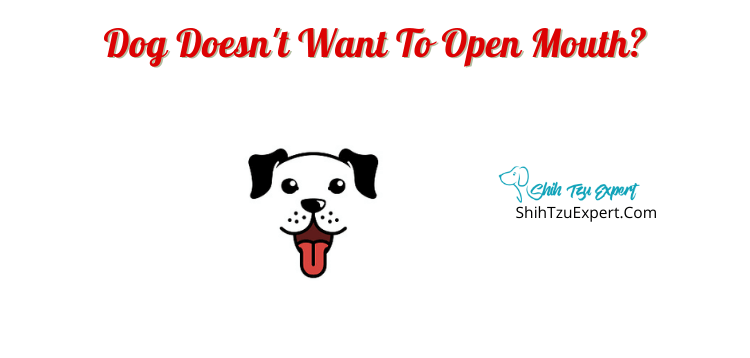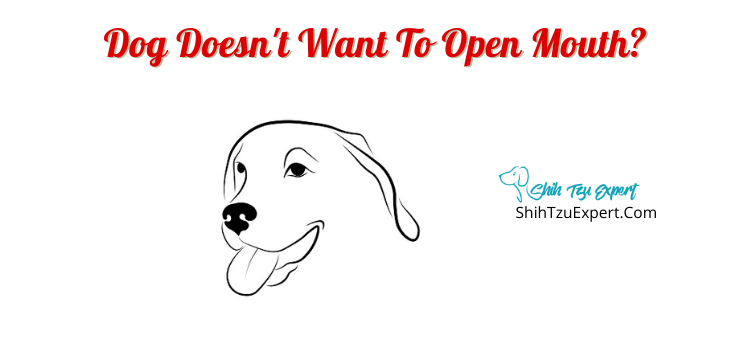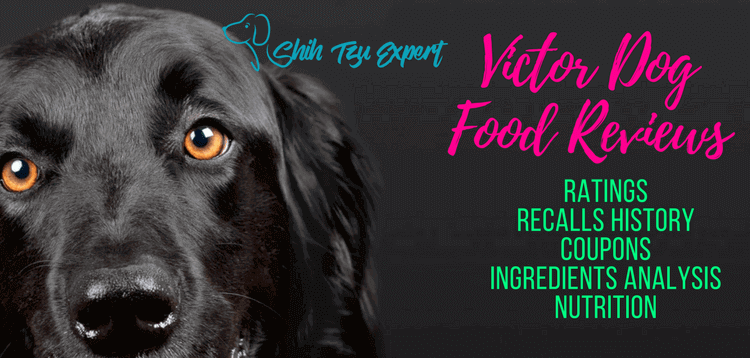When a dog’s mouth is shut tightly, there could be serious issues going on inside. In this article we will investigate the various reasons for a dog’s closed mouth, and the ways you can help your pooch.
Dog Doesn’t Want To Open Mouth?
If your dog is unable to open their mouth, you may need to investigate. Your dog may be unable to open their mouth due to pain. Never try to force your dog’s jaw open if it seems stuck. Approach the jaw gently and follow the helpful steps in this article.

Why Do Dogs Don’t Want To Open Their Mouth?
A dog who keeps their mouth closed could be doing it for a number of different reasons.
An anxious dog is prone to keep their mouth tightly closed. If the dog is in a new environment (such as a new home or going to the vet) or stressed in general, it will not open its mouth for you.
There is a good chance your dog’s inability to open their mouth is a medical issue. Your dog may be unable to open their mouth without experiencing pain. The medical term for when your dog cannot open their mouth is trismus.
One of the health concerns your pet may be experiencing is lockjaw. This locks your pooch’s jaw from being able to move. Lockjaw is painful and can affect your pooch’s ability to eat as well.
Another potential health issue that affects your dog’s ability to open their mouth is masticatory myositis. Masticatory myositis is a disorder within the dog’s immune system that incorrectly recognizes muscles as foriegn objects and attacks it. Masticatory is a muscle group in your dog’s jaw for chewing.
If your dog is experiencing masticatory myositis the muscles in their jaw will become swollen. Your dog will be in a lot of pain and similar to lockjaw, will be unable to open their mouth easily.
Larger dogs, such as dobermans and retrievers, tend to be more likely to come down with this immune system disorder.
Dog Cries When Opening Mouth Wide?

If your dog is crying when opening its mouth wide, you should book them an appointment with your local veterinarian dentist as soon as possible.
If your dog is crying from opening its mouth, this is a key sign that it could be experiencing a form of lockjaw or trismus. If it is not properly taken care of as quickly as possible it can have other negative effects on your pooch’s health.
For example, if they are unable to open their jaws easily, this will affect their ability to eat. If the muscles in their jaw are swollen and in pain, they will struggle to chew too. Yawning will also be a painful endeavor for them.
Dog Won’t Open Mouth And Drooling?
If your dog will not open their mouth and is dripping drool, there is a likely chance they are experiencing severe dental problems.
Drooling can be a sign of many different things. For some dogs, drooling is a completely normal daily occurrence. For others, it is a medical concern.
Drool can be a sign of a dog not feeling well. Older dogs that experience kidney failure will drool constantly with its mouth closed. This will happen with liver failure as well.
Dental disease will also cause drooling. Dental disease can be caused by tartar buildup on their teeth. It can also be caused by something getting stuck in your dog’s mouth and resulting in damage.
Your dog may not show signs of pain immediately, but if drooling is not a common aspect of your dog’s breed you should consult a veterinarian.
How To Release A Dog’s Lockjaw?
For treatment of a dog’s lockjaw consult your veterinarian. Do not attempt to release the lockjaw yourself. If you attempt releasing it without a veterinarian, you risk causing further damage and pain to your pooch.
Lockjaw treatment may involve a couple of different aspects, but very few will involve immediate relief and release. Your pooch may need to be on soft, soup-like food for a while.
If your dog’s lockjaw was caused by another disease, such as an infection, the care will involve treating the disease first. The veterinarian will likely prescribe antibiotics or other medications to help heal your dog’s disease.
Sometimes lockjaw will result in physical therapy for your dog. This will involve your dog having to slowly open their jaw or close it to help them loosen it up.
As with any ailment or pain, it is important to make sure your dog is getting enough nutrients and rest to help with its recovery. Soft foods that do not require chewing will be important.
My Dog Can’t Yawn Properly?
Sometimes a dog may jerk their head back while trying to yawn. This is likely a sign of pain for your pooch.
If you notice issues with your dog’s yawning abilities, you should consult your local veterinarian. Dogs are better at hiding pain than humans, so it may not always be obvious to you when your pooch is hurting.
If you see any jerking movements or note trouble opening their mouth fully during a yawn, do not ignore it. This may be your dog trying to let you know they are in pain.
How Do I Know If My Dogs Mouth Hurts?
There are a few signs that your dog will give you to let you know their mouth hurts.
- Eating habits
- Lethargy
- Dental appearance
Dogs are creatures of habit. If your dog’s eating habits have changed, there is a cause for concern. Dogs also love to eat and do so when they are bored whether they are hungry or not.
Dental issues will cause your pooch to stop eating as often or entirely.
If your dog suddenly has shown a lack of interest in their food or in playing, that is also another thing to note. When a dog is in pain, its characteristics tend to change. A playful dog will become distant and depressed.
Note any change to your dog’s personality and energy levels whenever you notice them.
If you think your dog may be in pain, check out their gums. Gently pull back their lips to expose their teeth and gums.
If a dog’s mouth hurts, often their gums will be swollen and red and could be bleeding as well. This could result in more drool coming out of their mouth.
Dental pain can also cause bad breath for your pooch. If you notice a big change in the smell of your dog’s breath, this could be a sign that they are in pain.
What Is The Gentlest Way To Open A Dog’s Mouth?
First, you should make sure your dog is used to you touching their mouth. This involves understanding your dog’s temperament and their comfortableness with you.
Start by placing a hand over the dog’s muzzle. Place your thumb and forefinger behind the canine teeth on each side of the mouth. The canine teeth are your dog’s super-sharp teeth that tend to be larger than their others.
Gently use your other hand to cradle your dog’s chin. Start to lift using the hand that is holding the teeth to gently pry your pooch’s mouth open.
Always remember to reward your dog for their good behavior and cooperation during this uncomfortable experience for them.
Should I Force My Dog To Open His Mouth?
You should never force a dog to open their mouth if they have a history of aggression. This could result in them biting you.
If you need to get your dog to open their mouth, try to do it as gently and firmly as possible with the aforementioned method.
There are plenty of reasons why you may have to force a dog’s mouth open, such as needing to brush their teeth or get them to take medications. Always make sure to be careful while doing it.
Can Dogs Get Tetanus?
Tetanus is not a very common issue for dogs. This does not mean that they cannot get it, but are less likely to have it compared to their human friends.
Usually, tetanus happens due to bacteria infecting an open wound. This particular bacteria is called Clostridium tetani. It affects the nervous system and causes muscle spasms.
What Are The Signs Of Tetanus In A Dog?
Different symptoms of tetanus for dogs may include:
- Stiff walking
- Muscle tremors
- Curled lips
- Lockjaw
- Drooling
If your dog is experiencing tetanus, it may start walking stiffly. The muscles closest to the infection may get tight causing difficulty in using that part of the body. You may also notice tremors in your dog’s muscles.
Lockjaw is a very common symptom of tetanus. Tetanus attacks the jaw and muscles in the face.
Why Does My Dog Not Let Me Open His Mouth?
There is a chance that your pooch is in pain and is trying to keep you away from their mouth to avoid being in further pain.
If you have not noticed any pain or other issues with your dog’s mouth, they may just not like you touching their snout. Opening a dog’s mouth can be an invasion of privacy for them sometimes. Some dogs just really do not like it.
If you have a history of having to open your dog’s mouth to put medicine in, they may associate your attempts at opening their mouth as a negative experience.
How Do I Teach My Dog To Open His Mouth?
As with any dog training, patience and treats are a must!
Gently placing your fingers on either side of their canine teeth and pulling up is a good way to get your dog to open their mouth.
After every time they open their mouths, remember to reward them with praise, pets, and treats. The more you do this, they will start to open their mouths automatically when you place your fingers there.
How To Get Dog To Open Mouth To Brush Teeth?
Get your dog used to the smell and taste of the toothpaste. Only get toothpaste that is made for dogs, as human toothpaste can be toxic for your pooch.
Choose a time and space that is calm and comfortable for your dog while you brush their teeth. Remove all other distractions.
Make it a habit to touch your dog’s mouth from time to time until they are comfortable with it. This will help them feel more comfortable when you go to brush their teeth.
Gently pull up the upper lip and start to brush. Remember to reward them by telling them how good they are.
You will have to gently open their mouths at the start of the process. As they get more comfortable with regular teeth brushing, they will start to open up their mouths on their own.
Dog Jaw Opener
Veterinarians may use specific instruments that hold a dog’s mouth open. These instruments are called mouth gags.
These are not recommended for use if you are not a professional!
These instruments will allow the vet to examine the dog’s mouth more clearly by keeping the jaw open.
How To Get Food Out Of A Dog’s Mouth?
Teach your dog the “drop it” command. To train your dog with this command, repeat the following steps a couple of times. Using one of their toys as the item in their mouth is an excellent way to learn the method.
If your dog is holding something in its mouth, hold up a treat for them. Tell them to drop what they are holding. Once they drop it, give them the treat.
This tactic can then be used for getting them to drop food they are hoarding in their mouths.
If the food is stuck in their mouths you may have to pry their mouth gently open to see it. Carefully open up their mouths to take a look in.
Never use your fingers to try and get something out of your dog’s mouth! Use a pair of tweezers to gently pull whatever is stuck in there. If the item has been in there too long, you may have to consult with a veterinarian to get it out.
How To Open A Dog’s Mouth To Give Medicine?
Gently tilt your dog’s head back and up. Hold onto the canine teeth with one hand and slightly pull the mouth open. Carefully put the medication into their mouth and close the mouth back.
Once they have chewed the medication you will be able to release their mouth.
If you are giving them liquid medication, the process is a little bit different. Instead of tilting their head up, use a syringe to push the medicine into their mouth.
References
https://www.vet.cornell.edu/hospitals/pharmacy/consumer-clinical-care-guidelines-animals/giving-your-dog-oral-medications
https://wagwalking.com/condition/embedded-objects-in-the-oral-cavity
https://www.thesprucepets.com/tetanus-in-dogs-4796657
https://vcahospitals.com/know-your-pet/masticatory-myositis-in-dogs
![12 Best Dog Foods for Toy Breeds [Buyer's Guide] 12 Best Dog Foods for Toy Breeds [Buyer's Guide]](https://shihtzuexpert.com/wp-content/uploads/2019/05/3-5.jpg)



